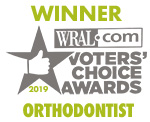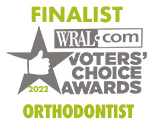Early Intervention
Early Orthodontic Treatment for Children
What is the difference between early orthodontic treatment and regular orthodontic treatment, and why might my child need early treatment? How will early treatment benefit my child in the long run?
These are just a few of the questions surrounding the topic of early orthodontic treatment for children. The American Association of Orthodontists recommends that children see an orthodontist as early as age seven. At this point the orthodontist will evaluate whether your child will need orthodontic treatment in the future.
Interceptive orthodontic treatment (also known as Phase 1 treatment) typically begins around age eight or nine. If necessary, Phase 2 treatment would begin around age 11 or older, depending on the timing of eruption of the permanent teeth as well as the timing of the patient’s growth spurt. A common goal of early treatment is to guide the eruption of the permanent teeth, often by opening space where excessive crowding exists. Certain jaw growth abnormalities are best corrected early, such as underbites or crossbites. The problems that are best corrected early are those that will continue to worsen over time.
Not all orthodontic problems need to be corrected with Phase 1 orthodontic treatment. If the crowding is not severe, and if there are no jaw discrepancies, most orthodontic problems are best treated in one stage of treatment in the early adolescent years.
How to tell if your child may need early orthodontic treatment:
-
-
- Early or late loss of baby teeth (your child should typically start losing teeth around age five, and will have all permanent teeth around age 13)
- Difficulty chewing and/or biting
- Mouth breathing
- Your child continues sucking his or her thumb after age five
- Speech impediments
- Protruding teeth (the top teeth and the bottom teeth extend away from each other)
- Teeth that don’t come together in a normal manner or even at all
- Shifting of the lower jaw when your child opens or closes his or her mouth (crossbites). The chin appears to deviate to one side when the child bites.
- Crowded front teeth as early as age seven or eight
-
What causes orthodontic problems, and how will early prevention benefit my child?
Orthodontic problems such as crowding of the teeth, too much space between the teeth, jaw growth problems, protruding teeth, and bad bites can be inherited or caused by injury to the mouth, early or late loss of baby teeth, or thumb-sucking and other oral habits.
Orthodontists will often use appliances that modify the growth of the jaws to correct crowding and bite imbalances. Once growth is complete and all of the permanent teeth have grown in, patients may require extraction of permanent teeth or jaw surgery to correct severe bite issues. Interceptive orthodontic treatment as a growing child can help prevent the need for more complex and invasive orthodontic procedures as the patient matures.
Most children have lost all their baby teeth by age 13. Upper jaw growth is complete by age 12 in both males and females. By approximately age 16 in girls and 18 in boys, the lower jaw growth will be complete. It is important to have an initial orthodontic evaluation before any of these milestones take place.
If your child is between the ages of seven and eight and shows signs of needing orthodontic care, or if you have been directed by your family dentist to visit the orthodontist, please contact our practice and schedule an appointment. Our team will provide your child with a complimentary exam and discuss with you the best steps to take toward caring for your child’s smile.
Visiting the dentist during orthodontic treatment
It is very important that you continue to visit your family dentist once every six months, even during your orthodontic treatment, for teeth cleanings and routine dental checkups. If extra dental care is needed, we will be happy to coordinate with your family dentist to make sure that you are receiving the best care possible.






